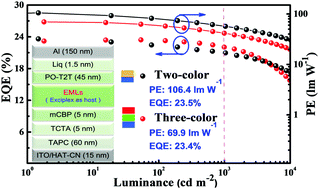Precise regulation of the emissive layer for ultra-high performance white organic light-emitting diodes in an exciplex forming co-host system†
Abstract
Nowadays, white organic light-emitting diodes (WOLEDs) have attracted more attention in solid-state lighting due to their merits of low power consumption, flat shadowless illumination, soft and weak blue light, flexible emission and so on. Regrettably, it is still an extremely challenging subject to achieve ultra-efficient WOLEDs exceeding 100 lm W−1. In this paper, we present a general approach to achieve low turn-on voltage (∼2.4 V), ultra-high efficiency WOLEDs based on an exciplex forming co-host system. The key to our design strategy is the precise management of the phosphor dopant concentration and the reasonable arrangement of the emissive layers to efficiently solve the trade-off between charge carrier trapping and energy transfer in electroluminescence (EL) processes. The resulting WOLEDs realize a forward-viewing maximum power efficiency and external quantum efficiency of 106.4 lm W−1 and 23.5%, 69.9 lm W−1 and 23.4%, respectively, for complementary-color and three-color WOLEDs. The EQEs retain over 22% at 1000 cd m−2, exhibiting extremely low efficiency roll-off. Such outstanding device performance and ultra-high efficiencies should be attributed to the enhancement of energy transfer and the reduction of charge carrier trapping in the exciplex co-host system. These findings will be conducive to enhancing the efficiency of WOLEDs, and promoting industrial development in lighting markets.



 Please wait while we load your content...
Please wait while we load your content...